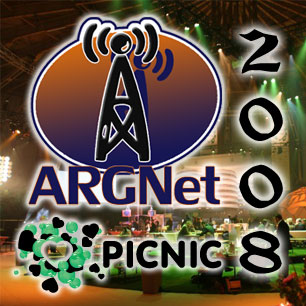 Image courtesy of stevecadman
Image courtesy of stevecadman
This past May, Tim Kring launched Conspiracy for Good, and as the summer comes to a close, the events of the past few months are coming to a head for one final event this weekend in London. If you can make it to Bloomsbury Square Gardens in London on August 7, register to play now, and this article should get you up to speed with what you need to know to join in the adventure.
Conspiracy for Good can best be described as an amalgamation of an alternate reality game, a street theater show, and a social movement. Players have been charged with the task of bringing down Blackwell Briggs, an evil global security firm with a penchant for kidnapping and skullduggery. Players willing to risk attracting Blackwell Briggs’ ire joined up with the Conspiracy for Good, an organization of socially-minded individuals committed to opposing the company’s excess.
Using a series of free mobile games available at Nokia’s Ovi Store, players were given the opportunity to hack into the Babbage 1.6.1 website to extract valuable pieces of intelligence, break into the Blackwell Briggs servers, and hack a series of CCTV cameras across London to help smuggle Nadirah, a key Conspiracy for Good member seeking to build a library for children in Zambia, into the city. The final mobile game lead to the next stage of Conspiracy for Good:Â a series of four live “Actions” occuring weekly in London. Participants at each Action are provided with a Nokia phone with pre-installed software to help complete the task.

 In the summer of 2008, Tim Kring and Christopher Sandberg were discussing the future of transmedia and community-based entertainment, standing on top of Isaac Mendez’ iconic post-apocalyptic tableau painted on the floor of the Heroes soundstage. As a result of that conversation, The Company P signed on to help produce Conspiracy for Good, a large-scale movement with alternate reality gaming elements.  Kring had previously pitched the concept for Conspiracy for Good to Nokia. The movement will play out “across both traditional media and new media platforms including smart mobile devices, game consoles, tablets, and PCs.”  At the heart of the experience is a locative event that will play out over the course of three weeks in London starting in mid-July and running until August 7th.  According to Kring, this is a great week to join in with the action, as “the narrative aspect really gets cooking as far as meeting key characters and key figures. A lot of the smoke that’s surrounding it will start to lift in the next few days.”
In the summer of 2008, Tim Kring and Christopher Sandberg were discussing the future of transmedia and community-based entertainment, standing on top of Isaac Mendez’ iconic post-apocalyptic tableau painted on the floor of the Heroes soundstage. As a result of that conversation, The Company P signed on to help produce Conspiracy for Good, a large-scale movement with alternate reality gaming elements.  Kring had previously pitched the concept for Conspiracy for Good to Nokia. The movement will play out “across both traditional media and new media platforms including smart mobile devices, game consoles, tablets, and PCs.”  At the heart of the experience is a locative event that will play out over the course of three weeks in London starting in mid-July and running until August 7th.  According to Kring, this is a great week to join in with the action, as “the narrative aspect really gets cooking as far as meeting key characters and key figures. A lot of the smoke that’s surrounding it will start to lift in the next few days.” Editor’s Note: Daniël van Gool, an administrator at the Unfiction forums, was on the scene at
Editor’s Note: Daniël van Gool, an administrator at the Unfiction forums, was on the scene at